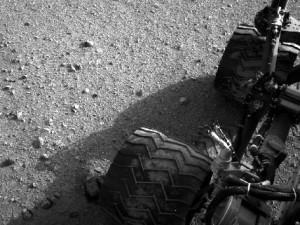 After NASA launched the Mars Science Laboratory in November last year, the Mars rover, Curiosity, landed on the Gale Crater on August 6th, exactly one month ago. Armed with a nuclear generator (solar panels were repeatedly covered by dust on the previous rover, Spirit), and high-tech instruments to gather, vaporize, and analyze Martian soil, Curiosity’s primary mission is to evaluate whether the general landing area could have or has the capacity to support microbial life. However, as noted in The Guardian and a CleanTech article last month, what we learn about Mars’ past—specifically, its climate history—could also inform and test our own climate change models developed for Earth.
After NASA launched the Mars Science Laboratory in November last year, the Mars rover, Curiosity, landed on the Gale Crater on August 6th, exactly one month ago. Armed with a nuclear generator (solar panels were repeatedly covered by dust on the previous rover, Spirit), and high-tech instruments to gather, vaporize, and analyze Martian soil, Curiosity’s primary mission is to evaluate whether the general landing area could have or has the capacity to support microbial life. However, as noted in The Guardian and a CleanTech article last month, what we learn about Mars’ past—specifically, its climate history—could also inform and test our own climate change models developed for Earth.
Though Mars and Earth have entirely different atmospheres, scientists’ knowledge of one planet will greatly enhance insight into the other. This is why studying Mars’ carbon cycle, the process by which carbon is naturally exchanged between a planet’s atmosphere, land, and oceans, is of particular interest. In the absence of heavy industrial activity, the carbon cycle maintains a relative balance which keeps the Earth’s temperature relatively stable. However, human activities (e.g. burning fossil fuels, deforestation, and many agricultural and industrial practices) have added a significant amount of carbon to the atmosphere, upsetting the balance. By studying the carbon cycle on Mars, NASA scientist Paul Niles believes we can learn more about what’s happening on Earth, and hopefully “be in a better position to make direct comparisons” between the two planets. Planetary scientist Mark Lemmon agrees: “The more we know about [Martian] atmosphere, the better we can really understand our own.”
Similar discoveries have been found in the past. When applying Earth’s climate model to Venus, it incorrectly predicted that Venus winds would come to a standstill within a few days. Scientists were then able to go back and refine the climate model, rendering it more accurate for both planets.
Image by NASA

